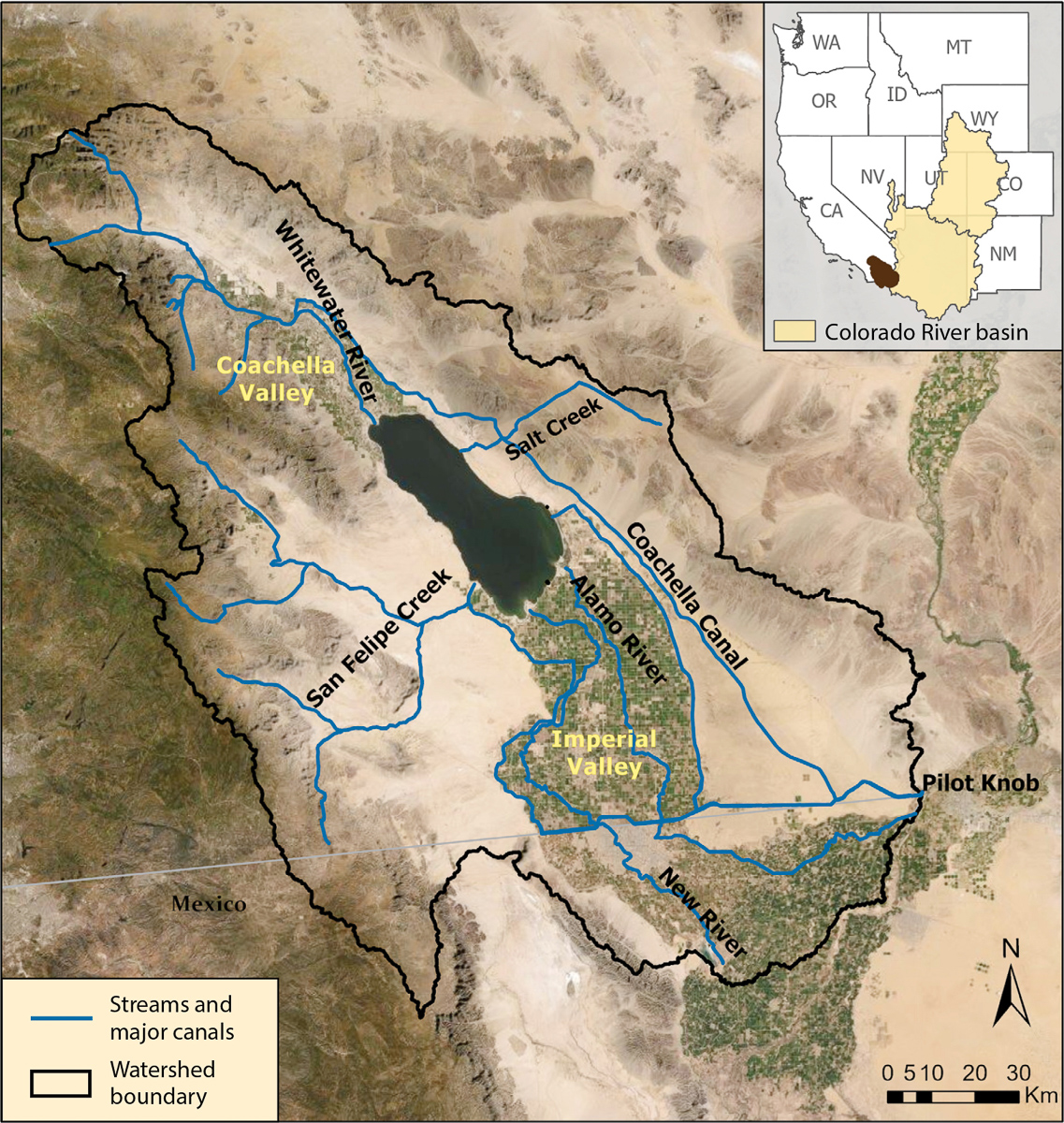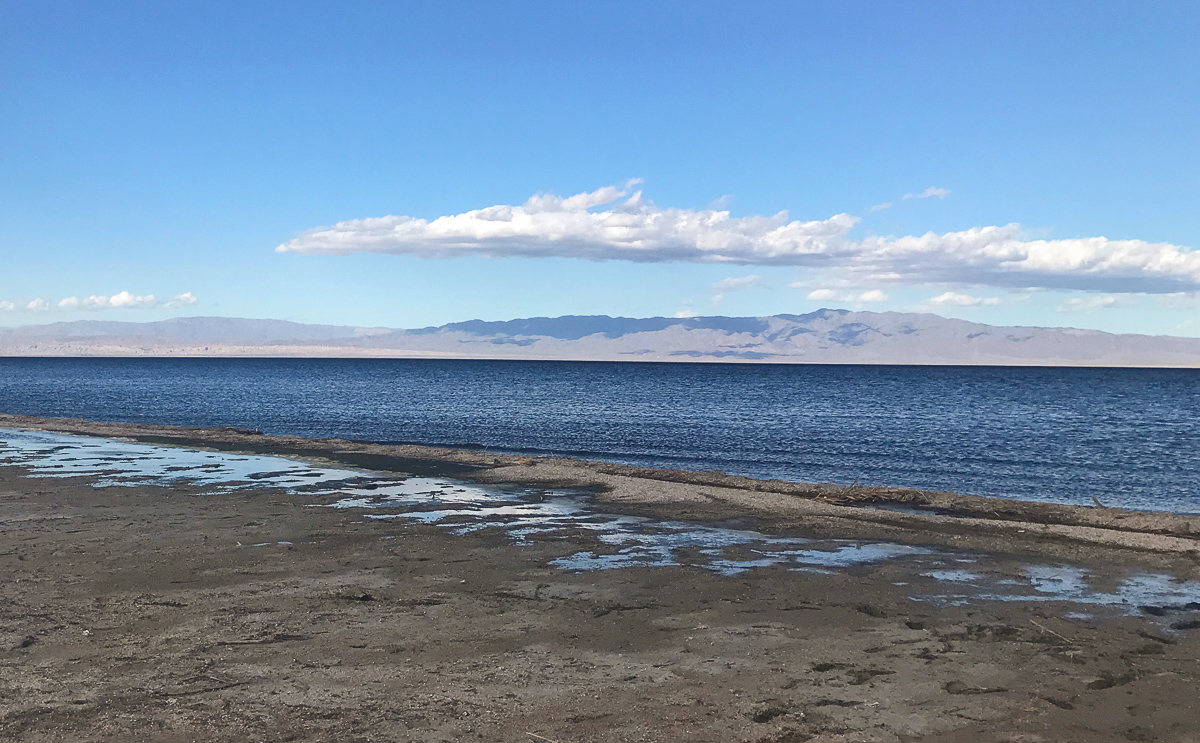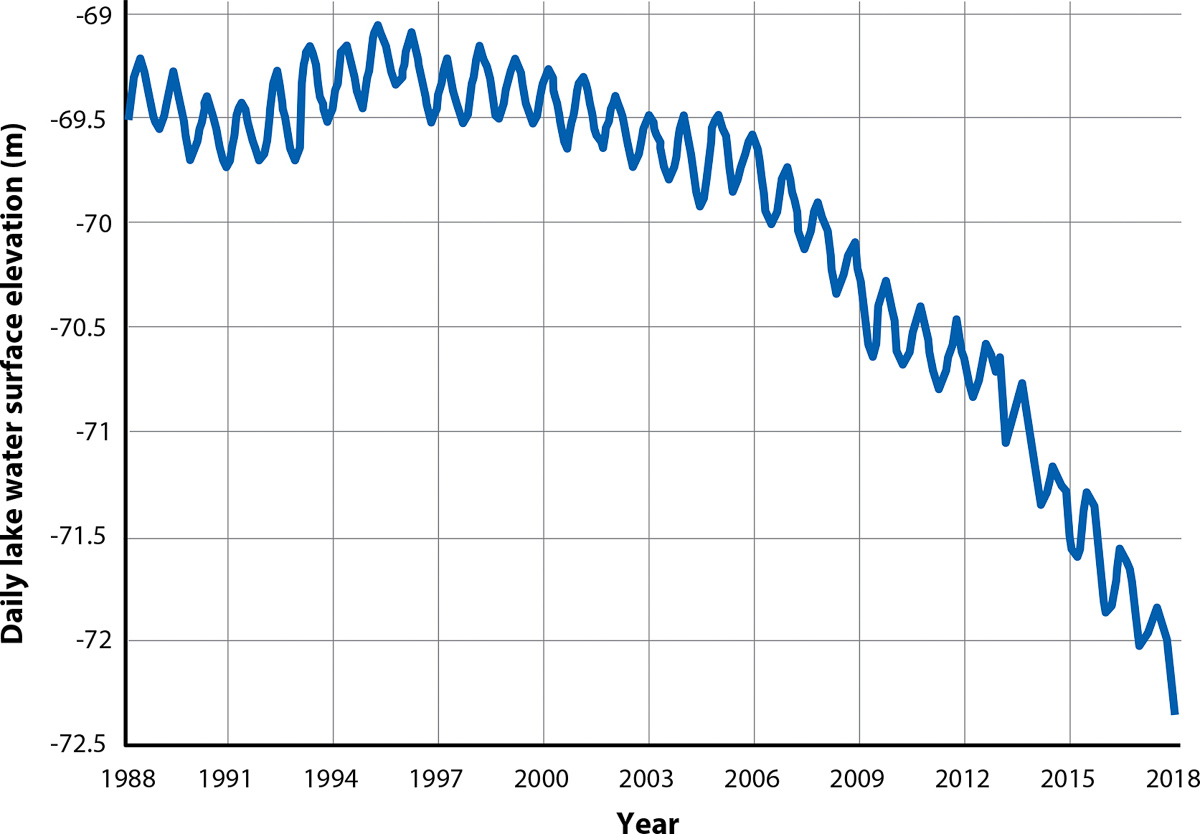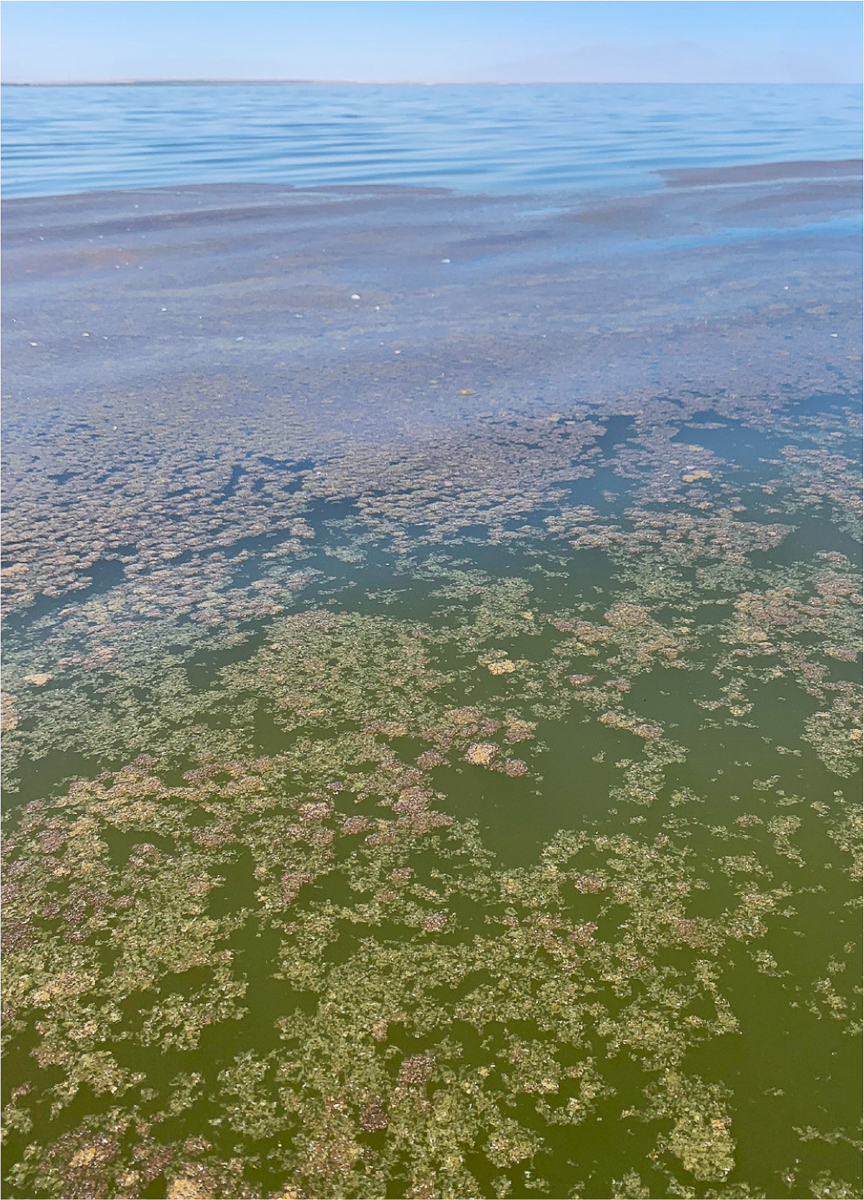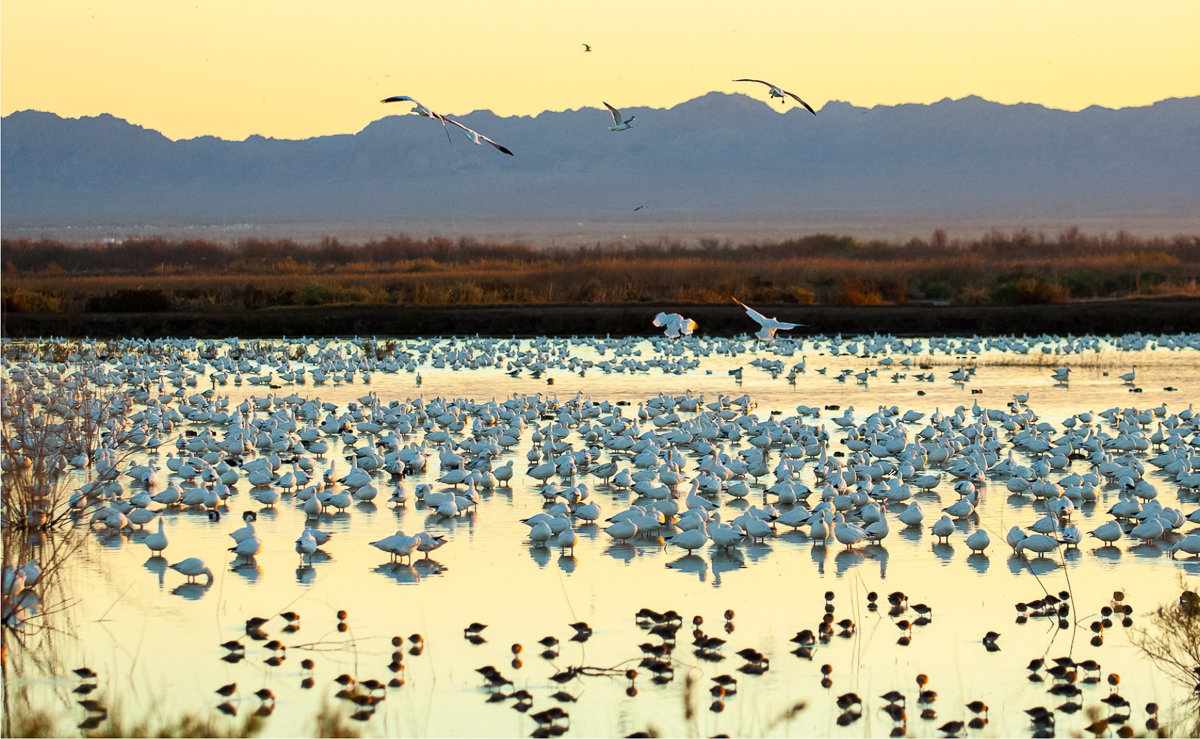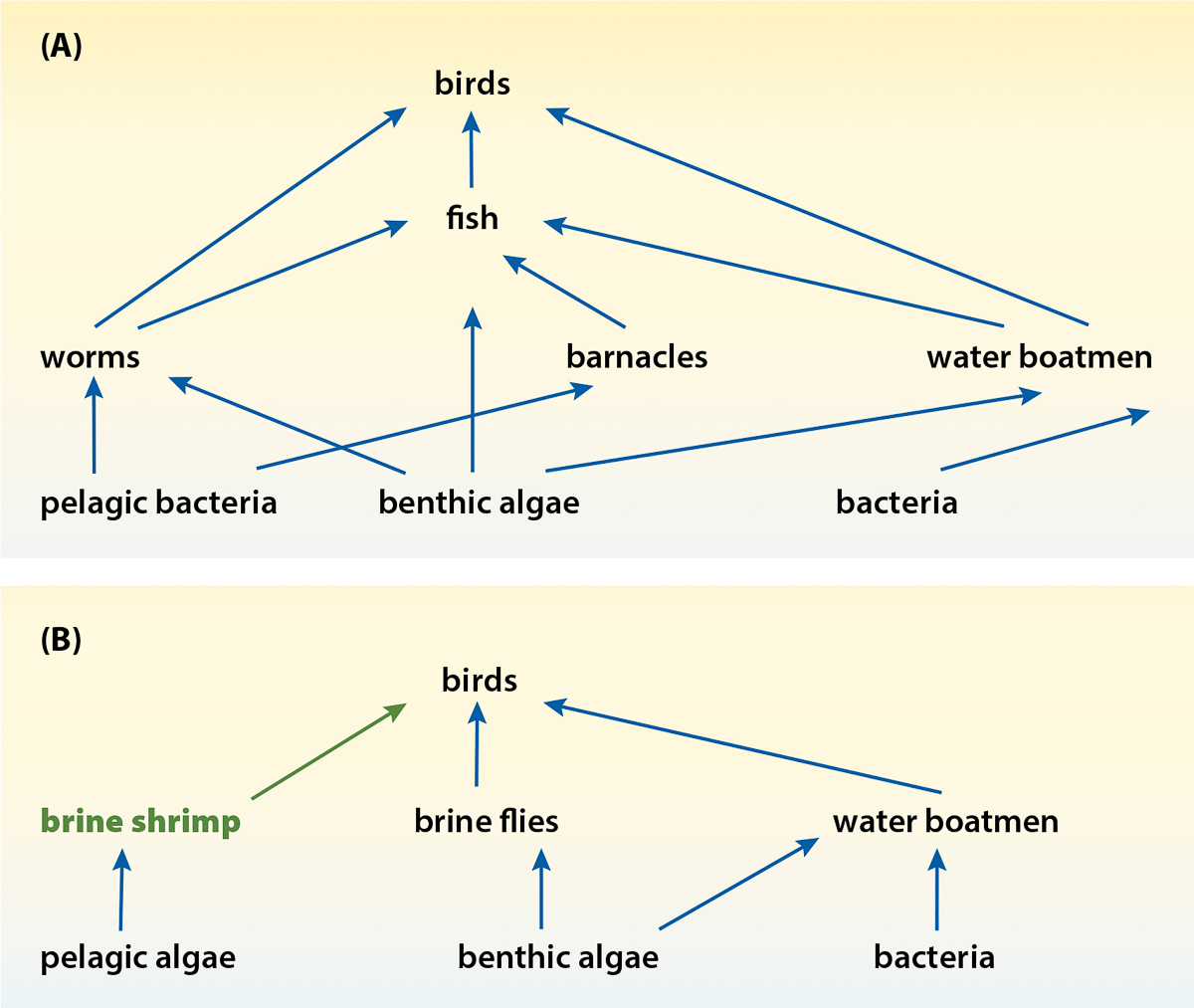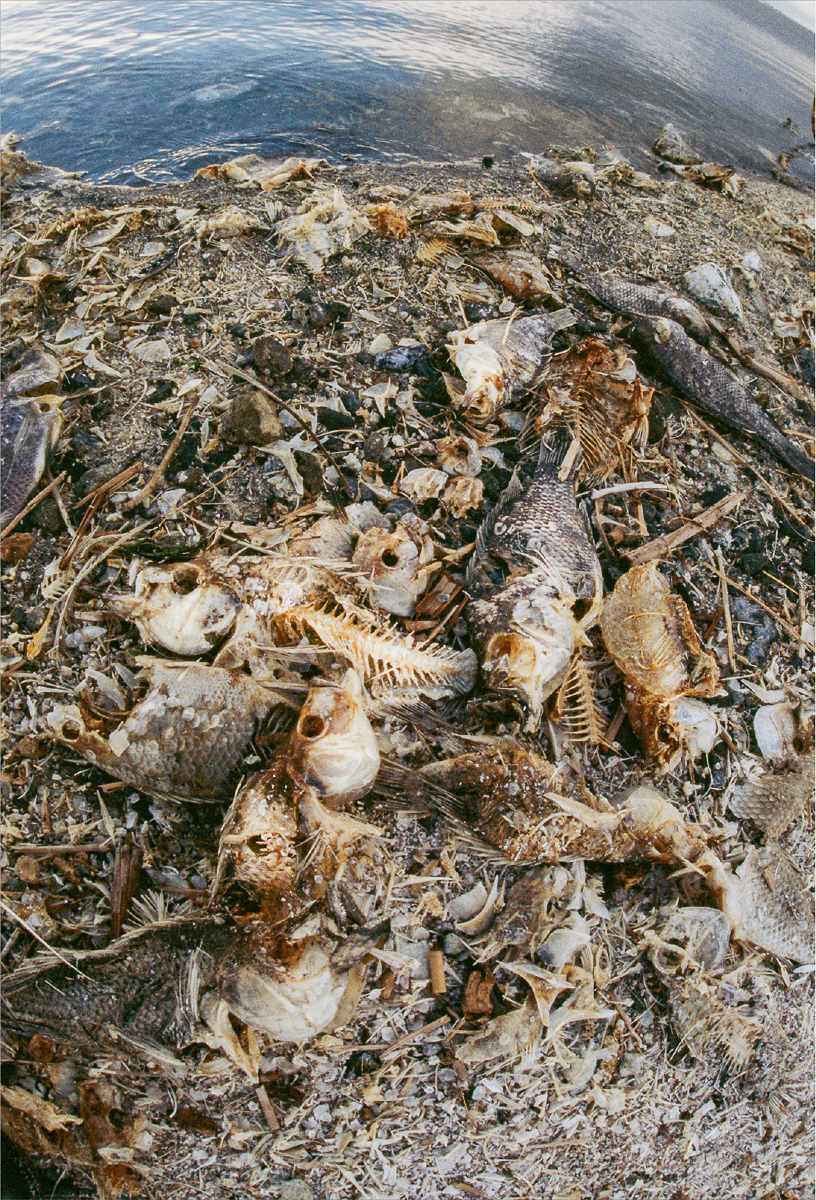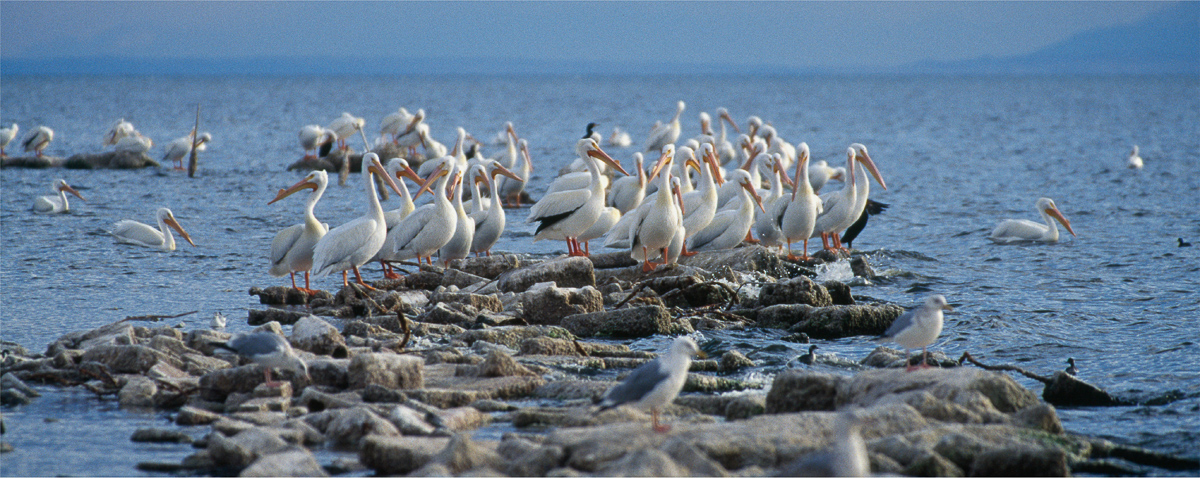All Issues
Ecological transitions at the Salton Sea: Past, present and future
Publication Information
California Agriculture 76(1):8-15. https://doi.org/10.3733/ca.2022a0004
Published online April 22, 2022
PDF | Citation | Permissions
NALT Keywords
Abstract
The condition of the Salton Sea, California's largest lake, has profound implications for people and wildlife both near and far. Colorado River irrigation water has supported agricultural productivity in the basin's Coachella and Imperial valleys since the Sea formed over 100 years ago, bringing billions of dollars per year to the region and helping to feed households across the United States. The runoff, which drains into the Sea, has historically maintained water levels and supported critical fish and migratory bird habitats. However, since 2018, a large portion of the water previously allocated for agriculture has been diverted to urban regions, causing the Sea to shrink and become increasingly saline. This poses major threats to the Sea's ecology, as well as risks to human health, most notably in the noxious dust produced by the drying lakebed. To ensure continued agricultural and ecological productivity and protect public health, management of the Sea and surrounding wetlands will require increased research and mitigation efforts.
Full text
The Salton Sea is an iconic landmark and California's largest inland body of water. It lies 255 feet (78 meters [m]) below sea level within the Salton Sea Basin, a rift valley located in the Sonoran Desert (fig. 1). The Salton Sea region is characterized by hot, arid conditions, classified under the Köppen-Geiger climate classification system as a hot desert climate (Kottek et al. 2006). Annual precipitation is less than 6 inches (150 millimeters [mm]) per year. The endorheic sea, lying in a deep basin, has no outlet. It contains saline water and covers an area roughly 344 square miles (890 square kilometers [km2]) in size with a maximum depth of around 49 feet (15 m). It has been a dominant feature of the regional landscape since its most recent formation event in 1905.
FIG. 1. Salton Sea basin and major tributaries and canals. Sources: Esri, DigitalGlobe, GeoEye, i-cubed, USDA FSA, USGS, AEX, Getmapping, Aerogrid, IGN, IGP, swisstopo, and the GIS User Community.
The Salton Sea has also been one of the most significant ecological sites in the Western Hemisphere since its formation, and it is especially important as a feeding site for migratory birds. The wildlife that lives in and around the Sea depends on inflows of irrigation water from the Colorado River, which has kept the Salton Sea viable and made the Salton Sea Basin an agricultural powerhouse. Recently, however, the ecological relationships that have sustained the region have experienced an abrupt change.
Water transfers to urban areas and declining water levels due to a warming climate have caused the Salton Sea to become increasingly saline, which poses major threats to the Sea's ecology and to public health. Photo: David Lo.
Dependence on the Colorado River
The current sea was formed when a flood on the Colorado River caused a breach in an irrigation canal. Though this event had clear anthropogenic influences, archaeological, stratigraphical and radiocarbon evidence throughout the basin have confirmed that the Colorado River has flooded the region multiple times over the past 1,300 years. This suggests that for much of the region's geologic history the presence of the Sea (referred to in its previous incarnations as Lake Cahuilla) was the norm rather than the exception (Waters 1983; Wilke 1978). During the years prior to European settlement, this ancient lake was a feature of great cultural significance to the Native American tribes in the region, providing fish from its waters and hunting grounds along its shoreline.
Recent isotopic studies have extended even further the lake's known history, revealing evidence of fluctuating lake levels due to large-scale climatic shifts between warm/wet and cool/dry periods over the course of the past 20,000 years (Li 2003). While the specific mechanisms responsible for individual inundation and desiccation events remain unclear (aside from the most recent), natural patterns of shifting Colorado River tributary channels appear to have periodically caused a complete diversion of the river's waters into the Salton Sea Basin, resulting at times in a lake surface area of over 2,200 square miles (5,700 km2) and depths of up to 312 feet (95 m), significantly greater than current levels (Waters 1983).
While the path of the Colorado River and its tributaries are now heavily mediated by human influences, shifts in precipitation and snowmelt will continue to impact the long-term fate of the present-day Salton Sea, with consequences for the human and ecological communities dependent upon it. Water lost to evapotranspiration under warming conditions over the past century is believed to have dominated increases resulting from concurrent precipitation changes, resulting in a climate-induced loss of water from the Upper Colorado River Basin — encompassing parts of Wyoming, Colorado, Utah, New Mexico and Arizona — where climate change projections are available. The amount of water lost is roughly equivalent to a 9.3% reduction per degrees Celsius of warming (Milly and Dunne 2020). Though there are significant uncertainties tied to future climate projections, especially with respect to changes in precipitation patterns, continuing temperature increases under moderate-to-high emissions projection scenarios are expected to increase the likelihood and expected duration of drought conditions in the Colorado River Basin and reduce total Colorado River flows by 35% to 55% over the course of the 21st century (Udall and Overpeck 2016).
The current iteration of the Salton Sea was formed between 1905 and 1906 after a flood on the Colorado River breached an irrigation canal and river water began flowing into the Salton Sink. In February 1907, the break on the Colorado River's levee was repaired. Many people expected that water levels would continue to decline and that, within a decade, the lake would disappear entirely in the hot, dry climate. However, the necessary irrigation of farms to the north and south produced agricultural runoff. This runoff flowed into the Salton Sea, and with the expansion of irrigated agriculture in the 1920s, kept lake levels high. By 1925, the water level had stabilized at 250 feet (76.2 m) below sea level (Blaney 1955).
Stability through agriculture
Agriculture using Colorado River irrigation remains vital to the Salton Sea Basin, where the frost-free climate allows year-round production of food and forage. As a result, the basin is home to some of the nation's most important and productive agricultural regions, including the Imperial Valley and the Coachella Valley. In winter, families enjoying a salad anywhere in the United States are almost certainly eating produce from the Imperial Valley. Agricultural production in Imperial County alone exceeds $2 billion per year (Kirby 2020).
The region's abundant agricultural productivity is dependent on the transfer of Colorado River water to the Salton Sea Basin via the All-American Canal. About three-quarters of all the water allocated to California from the Colorado River flows to the Imperial and Coachella valleys via this canal and its tributaries. The vast majority of the water is used for irrigation, with small allocations to residential and industrial users. Any water left over from these uses drains off and reaches the Salton Sea via the New River and Alamo River in the Imperial Valley Irrigation District (contributing 95% of total annual inflow) and the Whitewater River in the Coachella Valley Irrigation District (contributing 5%).
Irrigation runoff has been the major source of inflow into the Salton Sea since its formation in 1905–1906. This includes additional runoff from soil drainage, which is necessary to eliminate excess salt in the root zone. The soils in the basin are salty because they lie beneath what were earlier, larger versions of the ocean. The excess flow carries the salt away from the crops' root zones, reducing soil salinity and maintaining productivity. Ephemeral flows from dry washes and groundwater also add water to the Salton Sea, though the exact contribution of these sources is not well known. All of these together — agricultural irrigation, soil drainage and flows from dry washes and groundwater — have countered evaporation and discharge to groundwater for nearly 100 years.
Declining water levels
Despite the input of agricultural runoff, lake surface water elevation measured near Westmorland has shown a slow decline in the Sea level since 1995 (fig. 2). This decline mirrors modest reductions in agricultural runoff. Total annual mean Colorado River inflow to the Salton Sea basin via the Alamo, New and Whitewater rivers, as measured at Pilot Knob (fig. 1) between 1980 and 2018, was 0.95 cubic miles per year (mi3/year; 3.95 cubic kilometers [km3]/year), out of which 0.32 mi3/year (1.35 km3/year) reached the Sea via the Alamo, New and Whitewater rivers. A significant decline in annual inflows from 1995 to 2016 coincides with a declining trend in lake level during the same period, from 226 feet (69.2 m) below sea level in 1995 to 236 feet (72 m) above sea level in 2016. These changes in lake water levels cannot be explained solely by declines in the inflow rate; other losses, such as those caused by evaporation and discharge to groundwater, impact lake water levels as well. Despite various efforts to project inflow rates to the Salton Sea, no comprehensive assessment of surface water-groundwater interactions has been performed to quantify surface water-groundwater exchanges.
FIG. 2. Daily lake water level observations at the Salton Sea near Westmorland (USGS 10254005), NGVD 1929.
Water transfers
Early in the 21st century the Quantification Settlement Agreement (QSA) was established, mandating annual water transfers from the Imperial Valley to urban regions in California, including the San Diego Water Authority, the Metropolitan Water District and the Coachella Water District (Cohen 2014; Little Hoover Commission 2015). The threat that these water transfers posed to the Salton Sea was widely studied and reported, including studies of the ecology, hydrology and chemistry of the Sea and its surrounding basin (Gonzalez et al. 2005; Riedel et al. 2002; Schroeder et al. 2002). These scientific studies later supported a number of reports sounding alarms about the ecological, public health and economic consequences of the proposed water transfers (Cohen 2014; Little Hoover Commission 2015). Responding to the numerous studies predicting negative effects of the water transfer, the state of California mandated that mitigative flows of Colorado River water be transferred directly to the Sea for 15 years. These flows were intended to provide time to determine and implement a solution to avoid the numerous negative effects of the water transfers. Unfortunately, despite the analysis of numerous alternatives, no mitigative plan was implemented.
In 2018, the QSA initiated the largest agriculture-to-urban water transfer — on the order of 200,000 acre-feet of water per year — in the history of the United States. Since then, though many of the changes predicted in the studies mentioned above have occurred, scientific investigations have become much less frequent. Instead, the focus has been on developing the Salton Sea Management Program (CNRA 2020), apparently under the assumption that the physical and ecological processes at the Salton Sea are sufficiently well known.
Salton Sea ecology
For more than a century, the Salton Sea has been perhaps the most important feeding site in the western United States for dozens of migratory and resident bird species, especially those feeding on fish. Along with the Florida Everglades and the Pantanal marshes of Brazil, the Salton Sea has ranked among the most significant ecological sites in the Western Hemisphere in terms of the number of bird species present, feeding and breeding on its shores (Shuford 2014). However, changes in the Sea's water supply, as outlined above, have initiated drastic changes in the area's ecosystem, threatening agricultural production, wildlife habitat and public health.
Upon its formation early in the 20th century, the Salton Sea had a salinity near that of seawater (35 parts per thousand [ppt]). Marine organisms, including the valued game fish species sargo (Anisotremus davidsoni), Gulf croaker (Bairdiella icistia) and orangemouth corvina (Cynoscion xanthulus), were introduced into the Sea, and a thriving sport fishery ensued. Tilapia (Oreochromis mossambicus x O. urolepis hornurum) were introduced later. Desert pupfish (Cyrinodon macularius) and sailfin molly (Poecilia latipinna) are highly saline-tolerant species found in streams and canals contiguous with the Sea (Gonzalez et al. 2005; Lorenzi and Schlenk 2014; Riedel et al. 2002; Sutton 2002).
The Sea also became a vital feeding site for millions of birds migrating along the Pacific Flyway. In particular, the Salton Sea was the single most important inland site in North America for millions of fish-eating birds migrating along the Pacific Flyway, including species such as egrets, herons, rails, terns, cranes, cormorants, grebes, seagulls, and white and brown pelicans (Shuford et al. 2002; Shuford 2014). Over the past century the Salton Sea ecosystem became all the more important as productive marshes were gradually eliminated from the Colorado River delta, the Central Valley and the California coast.
For more than a century, the Salton Sea has been an important feeding site for dozens of migratory and resident bird species. Photo: Steve Payer, CDWR.
By the latter part of the 20th century, irrigation water imported into the Imperial Valley from the Colorado River was supporting three valuable enterprises: agriculture, bird migration and tourism. Tourism was supported by several marinas and resorts along the Sea's shores and provided an additional economic boost to a region already popular with winter visitors.
Over time, a series of calamities sullied the attractiveness of the Sea for tourists (deBuys 1999). In the late 1970s, a number of large storms dropped so much rain in the region that the water level in the Sea rose, damaging marinas and resorts. By this time, other, longer-term changes were already at play. For decades, irrigation water from the Colorado River, itself one of the saltiest rivers in the world, had been carrying additional salt leached from agricultural fields into the Sea. Over time, as the water evaporated, the salt carried to the Sea was left behind.
Early in this century, the salinity of the Sea finally rose to levels that were lethal to sargo, croaker and corvina, the most valuable sport fishing species in the Sea. Of the major larger fish species, only Tilapia remained. Many of the smaller fish, including the desert pupfish and sailfin mollies, were also eliminated from the main body, presumably as a result of predation by the Tilapia.
As water continues to flow into the Sea from agricultural fields, it brings not only salts, but also nutrients (Holdren and Montano 2002). These constituents accumulate and concentrate in the Sea as the water evaporates, leaving the nutrients behind. The Sea therefore supports a thriving, highly productive aquatic food chain, rooted in algae, with nutrients and energy passing upward through crustaceans, insects and worms, then to fish and eventually to birds and humans (fig. 3A). This high level of productivity is typical of salt lakes throughout the world because they concentrate nutrients from a wide region in a rich aqueous environment. This, coupled with the sunshine typical of the desert regions in which these lakes occur, provides the ingredients for extraordinary biological productivity.
FIG. 3. Illustrations of food webs at the Salton Sea. (A) The food web at the Salton Sea at the beginning of this century. Algae and bacteria at the base of the food web feed fish directly (particularly Tilapia) and indirectly through a variety of invertebrate species. Both fish and invertebrates served as food sources for abundant bird populations at the sea. (B) The food web currently at the Salton Sea (shown in black text). The substantial elimination of fish has caused a decline in fish-eating species. Shorebirds and gulls continue to feed on invertebrates. Brine shrimp (shown in green) are currently missing from the food web, although they are important components at other salt lakes such as Mono Lake and the Great Salt Lake.
In the case of the Salton Sea, abundant algae, invertebrates and fish have contributed to the constant deposition of algae, feces and dead organisms that settle down and rest on the Sea's bottom (the benthic zone). This rich organic ooze supports abundant bacteria and fungi that consume all of the oxygen available. As a result, the waters in the benthic zone are anoxic, devoid of oxygen and unable to support most animal life. Nonetheless, in the well-stirred and well-aerated surface waters, plant and animal life abound. Occasionally, strong winds blowing across the desert ruffle the surface of the Sea, pushing the surface waters aside. This displacement of the surface water causes the anoxic bottom water, rich in hydrogen sulfide and poor in oxygen, to rise to the surface, where it causes massive fish kills.
It is never the case that all of the fish in the Sea die in one of these events; the lifting of bottom water is local. But local fish kills lead to windrows of millions of fish washing up onto the shores of the Sea. The hydrogen sulfide brought to the surface escapes as a gas, leading to an acrid smell most accurately described as that of rotten eggs. Not surprisingly, these periodic windrows of dead fish and smell of rotten eggs have done little to enhance the Sea's reputation as a tourist destination.
Over the course of its 110-year history, the Salton Sea has gradually transitioned from a salt lake with abundant fish populations and a salinity close to that of the oceans (35 ppt), to what has become a eutrophic, hypersaline lake (61 ppt) supporting only a single saline-tolerant fish species (Tilapia) at the top of the aquatic food chain. Nonetheless, up until the year 2017, the Sea continued to serve as a feeding and resting site for a large and diverse array of bird species. In 2018, all of this changed.
A future in transition
Beginning in January 2018, the mitigation flows that had been entering the Salton Sea as a requirement of the QSA were terminated. The massive water transfers that occurred that year caused the Sea to begin a rapid decline in volume and a rapid increase in salinity. As the Sea recedes, thousands of acres of previously submerged sediments are being exposed. Given the dry and windy conditions in the area, there is concern that these dried lakebeds (playa) may become a source of highly toxic dust (Biddle et al. 2022; Parajuli and Zender 2018).
The reduced inflows of water will also accelerate the rate at which salinity increases. Current reports suggest that the Sea's Tilapia populations have already dropped to levels that no longer support the large populations of fish-eating birds that have fed there in the past (Jones et al. 2019). Scientists estimate that all fish species will be excluded from the main body of the Sea when its salinity reaches 70 ppt, an event likely to occur within the next few years as a result of the QSA-mandated water transfers to urban centers (Little Hoover Commission 2015). Elimination of most fish from the Salton Sea has opened the habitat to more saline-tolerant invertebrate species and raised the possibility that the Sea may transition into a hypersaline salt lake similar in ecology to California's Mono Lake and Utah's Great Salt Lake (fig. 3B). These highly saline lakes, even saltier than the Salton Sea, have abundant populations of brine shrimp that feed on pelagic algae as well as large populations of brine flies that feed on benthic algae (Dana and Lenz 1986; Herbst and Bradley 1989; Herbst et al. 1988). The brine shrimp at Mono Lake are in the species Artemia mono, while those at the Great Salt Lake are Artemia franciscana. The brine flies at Mono are principally Ephydra hians, while those at the Great Salt Lake are a mixture of E. hians and E. cineria. It is unclear which species might eventually colonize and predominate at the Salton Sea, but it should be pointed out that the salt composition at the Salton Sea is much more similar to that of the Great Salt Lake than it is to that of Mono Lake, a lake rich in sulfate and with a pH close to 10.
The current ecological transition at the Sea has not led to abundant brine shrimp populations. Instead, bugs called water boatmen (Trichocorixa sp.) have shown explosive population growth following the decline of the Tilapia. The water boatmen population has become so large that they pose a nuisance to surrounding communities. When they migrate out of the Sea, they cover cars and other shiny surfaces and clog swimming pool filters in cities as far away as Palm Springs (Sadler 2017).
Fish remains on the North Shore shoreline of the Salton Sea in Riverside County, California. For years the Salton Sea has been shrinking, leaving dry lakebeds, saltier waters and a damaged ecosystem. Photo: Steve Payer, DWR.
Herbst (2006) has reported that water boatmen suppress brine shrimp in saline habitats in the Sonoran Desert. Our own microcosm studies using water boatmen from the Salton Sea found that water boatmen completely eliminated brine shrimp when the shrimp were presented in either the cyst or larval stages of their life cycle (T. Bradley, unpublished data). It may be that brine shrimp will be excluded from the Sea until the water boatmen populations decline. No one can predict when that will occur, because the saline tolerance of the water boatmen at the Sea has not been determined.
The huge populations of water boatmen at the Salton Sea do provide forage for a limited number of aquatic and shorebird species, but the rapid changes in water level and salinity at the Sea have reduced feeding habitat for several other bird species, including brown pelicans and cormorants. To address this problem, state agencies in California, notably the California Natural Resources Agency (CNRA), have proposed constructing mitigation marshes on the shores of the receding Sea (CNRA 2020). CNRA managers plan to mix low-salinity irrigation runoff water with Salton Sea water to produce moderately saline water. The introduction of saline water to the marshes would inhibit the growth of cattails and rushes, providing open-water feeding habitat for the fish-eating bird species that have used the Sea in the past. The mitigation marshes are intended to provide biological habitat, but they will also serve to reduce dust generation from the playa. It is anticipated that over 40,000 acres of playa will be formed by the year 2040. While many acres of mitigative marshes have been proposed, little progress has been made to date, as funding and permitting issues have delayed construction.
Meanwhile, there are other concerns about the changing ecosystem of the Salton Sea. Mosquitoes breed abundantly in the salt marshes adjacent to the Sea, where salinities can exceed those of the open ocean (T. Bradley, unpublished data). Mosquito larvae are rarely found in large, open bodies of water, but this is normally due to exclusion by fish. Mosquito production in the mitigation marshes should be low if fish are present. However, there is a concern that mosquito production in the Salton Sea could occur in the absence of fish, a very serious outcome as mosquitoes in these warm regions can act as vectors of West Nile virus, Western equine encephalitis and St. Louis encephalitis.
The elimination of fish species from the Salton Sea may also impact water quality and clarity. At present, abundant anaerobic metabolic byproducts are produced in the anoxic benthic regions of the Sea (Schroeder et al. 2002). These include ill-smelling organic gases, including hydrogen sulfide. As a result, the Sea is unattractive for many recreational purposes due to a rotting egg smell. In the past, the water in the Salton Sea frequently has had a Secchi depth (which measures clarity) of less than a meter due to the abundance of pelagic algae (Holdren and Montano 2002). Mono Lake, which currently has a salinity of 81 ppt, close to that of the Salton Sea (61 ppt), experiences a clearer water column during the summer. This allows benthic algae to proliferate over extensive acreage. The downward extension of the photic zone through benthic algae produces oxygen at greater depths. If, in the future, the aerobic zone in the Salton Sea should extend deeper into the water, as it does at Mono Lake, it would affect the concentration of dissolved selenium.
Selenium accumulates readily in algae and invertebrates, which are in turn fed upon by fish and birds. A powerful teratogen, selenium can cause fetal and embryonic deformation at very low environmental concentrations in fish, birds and mammals (Spallholz and Hoffman 2002). Selenium occurs naturally in soils in the western United States. Irrigation wastewater can be high in selenium following solution of selenium in the water and subsequent concentration through evaporation. The water flowing to the Sea from agricultural runoff contains total selenium concentrations ranging from 2 to 30 parts per billion (ppb) (Johnson et al. 2009), a range that can at times exceed the maximum level permitted in open waters by federal regulation of 5 ppb. The water in the Salton Sea itself is low in dissolved selenium because selenate and selenite become reduced in the anoxic regions of the Sea and precipitate into the sediment (Schroeder et al. 2002). A deeper aerobic zone could instead cause the selenium to be oxidized and thus solubilized (Schroeder et al. 2002), leading to levels of solubilized selenium sufficient to cause dangerous bioaccumulation.
There is concern that selenium might also increase in the mitigation marshes being constructed around the Sea because there are high levels of this mineral in the runoff used to fill them (Ohlendorf and Marois 1990; Setmire et al. 1993). While the marshes are essential as a means of protecting the health of hundreds of thousands of residents in the adjacent communities, they also pose grave risks for bioaccumulation of selenium (Ohlendorf and Marois, 1990; Setmire et al. 1993). It will be essential that the selenium levels in both the marshes and the Sea itself be carefully monitored, and that corrective measures be taken if selenium levels are found to reach a level of concern.
Future management plans
Future management plans for the Salton Sea watershed should consider a holistic approach to water resources management in terms of both quality and quantity. Regionally, the QSA-mandated transfer of water from the Colorado River to urban centers must take into account the full consequences of this action on agricultural productivity. Agriculture provides a vital economic stimulus to this region, as well as being the source of fruits and vegetables consumed year-round across the United States.
The transfer of water has caused a rapid decline in the volume of the Sea, resulting in increased salinity, decreased fish and bird populations, and several public health concerns, including toxic dust from thousands of acres of dried lakeshore. As discussed in a companion paper in this volume, research investigating the possible health effects of the dust deriving from these emissive shores is urgently needed.
The construction of hundreds of acres of marshes along the newly emerged shorelines proposed by the CNRA is designed to reduce dust and provide fish and bird habitat. A serious challenge to this effort is the high levels of selenium in the agricultural runoff used to fill them. Proper construction and management of the marshes will require careful attention to water access and transfer rates, salinity regulation and vegetation control. Emphasis to date has been on dust control, but mitigation for the loss of bird habitat should also be a valid concern.
Clearly, the decision to transfer water from agriculture to urban uses has created serious economic, public health and environmental issues for the region. Mitigating these effects while dealing with the challenges of global warming and reduced Colorado River flows will be a major challenge, but one that must be met for the sake of California's human and ecological communities.



